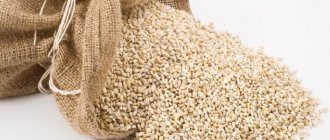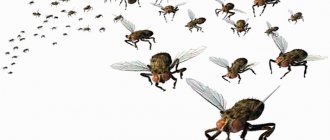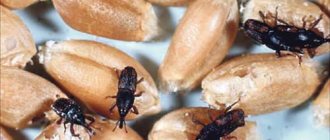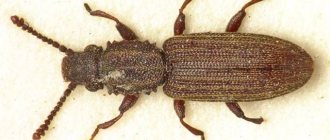Sooner or later, almost every kitchen is faced with an invasion of parasites. It is noteworthy that the appearance of worms does not at all depend on the housewife’s neatness: they can appear even in a perfectly clean kitchen.
Any kitchen can be attacked by a wide variety of parasites.
Let's figure out how these parasites threaten your kitchen, where they come from and, most importantly, how to get rid of bugs in the kitchen.
Why do bugs appear in the kitchen?
First of all, you need to understand that if you have food in your kitchen, then bugs can appear in any case, no matter how hard you try to maintain order.
Cereals receive bugs while still in the warehouse.
There may be several sources of infection:
- The most common way bugs appear in the kitchen is from the grocery store. Do not be surprised. Even a hermetically sealed bag of cereal can contain parasite larvae and adults. They can get into cereals and groceries both directly during sorting and already in the store if storage conditions are violated.
- From neighbors through ventilation. If your neighbors turn a blind eye to the problem, sooner or later strike squads of bugs will make their way to you through the ventilation. Since they reproduce very quickly, their presence will soon become noticeable.
- Some parasites can be found in textiles or wooden products. Therefore, we recommend that you wash towels or oven mitts well, and put wooden utensils in the freezer for a couple of hours.
Note! Even one spotted bug is a reason to be wary and take treatment and prevention measures. Therefore, carefully monitor the condition of your kitchen and do not neglect processing cereals after purchasing them.
In addition, many bugs love animal food, so it is better to put it in the pantry or refrigerator.
Where are the bugs hiding?
If insects appear in the kitchen, then general cleaning is essential. We'll have to check everything. After all, kitchen pests are practically omnivorous. Neither red pepper nor medicinal herbs scare them.
Note! It is best to complete the search in one day because the bugs can multiply quickly.
The work plan is as follows:
- Sort through all the cereals. If living creatures were found in open packages, then most likely they have already gnawed through the sealed products. Open and check everything!
- Don't forget to check the salt. Perhaps the emerging insects are not connoisseurs of sweets.
- Beans are a favorite delicacy. If dark spots appear on the beans, throw them away. In the future, try to store beans only in the freezer.
- Check all the seasonings and first aid kit. Kitchen pests are partial to ordinary mustard plasters. Be sure to review all packaging.
- Don't forget about tea and coffee. A floating insect in a cup is quite a sight!
- Sort through all the vegetables. Some beetles do not disdain onions.
- Move all the furniture and check the cracks. If during this time you managed to find several clusters of beetles, you will have to check the entire apartment.
- Inspect the window sills and floors.
- Check all equipment. Don't even ignore the iron.
Types of bugs
It is important to understand that depending on the type of new kitchen inhabitants you have, methods of dealing with them may vary significantly. And sometimes they are not needed at all: for example, small (less than one millimeter) white bugs that can occasionally be seen in the kitchen are ordinary wood bugs. They feed on dust from your furniture, are non-toxic and do not harm human health.
White bugs: not a very pleasant, but harmless neighborhood.
True, there is another side to this - they can serve as food for other bugs with more unpleasant behavior. Therefore, we recommend that you read the information below and try to determine who you are up against and what products you may have to throw away.
One of the most common types of bugs in the kitchen is the red flour beetle. This is a tiny parasite, up to two millimeters in length, with small, hard wings of a bright red color. By themselves, they are quite harmless: they do not eat food and do not live long. However, they multiply quickly. Their small white larvae are almost invisible in foods: flour, rice, oatmeal. Small worms actively feed on cereals, leaving waste in them and spoiling the food.
Red flour eaters feed not only on flour, but also on everything they can get their hands on.
Determine: Musty smell and holes drilled in the grains.
The mealworm is much more dangerous for humans. A brown bug up to three millimeters in size has a mustache and powerful mandibles. You can find it in stocks of flour or potato starch, but there are also not too whimsical individuals for which any crumbly product will suit.
Not only destroys food, but also harms health.
It is noteworthy that they do not strive to completely eat even their favorite flour - as soon as it begins to smell unpleasant, the entire colony migrates to the next container.
Their danger lies in the fact that the waste products of the flour beetle are dangerous to humans and can cause serious poisoning.
Determine: Products gather in lumps and acquire a damp smell.
The peculiarity of the bread grinder is its incredible gluttony. The four-millimeter bug is ready to eat any food that can be found in your kitchen cabinets: flour and pasta, cereals, beans, coffee, tea, nuts, dried fruits and even tobacco.
A small bug can drain all your supplies.
There is no particular harm from it, but a few bugs can ruin a significant amount of stock.
Determine: Usually they don’t hide much, so they are immediately visible.
It should be noted that some people prefer to classify food moths as bugs in the kitchen. This is fundamentally incorrect: moths are a completely different species and need to be dealt with using other methods. We wrote more about how to get rid of food moths in this article.
Is it possible to eat contaminated cereals and flour?
Bugs that appear in the kitchen cabinet indicate that the food has been contaminated. Pest control should be started urgently, as they multiply exponentially. Flour, beans, cereals, tea, spices and other groceries are not suitable for human or pet consumption. You need to get rid of them without regret.
Contaminated products
Are bugs in the kitchen dangerous?
It is difficult to unequivocally assess the harm from the presence of bugs in the kitchen for human health: if you do not eat them directly, they do not seem to be able to do much harm.
Eating such foods is not only unpleasant, but also dangerous.
However, the main danger of parasites is that they leave excrement, shells of larvae, cobwebs and particles of their scales. Such a food supplement will not bring any benefit, and in some cases it can provoke serious anaphylactic shock. Therefore, we still do not recommend there are products that are infested with bugs.
On the other hand, the taste also leaves much to be desired: bugs give all products an unpleasant musty taste, as they eat away their core, leaving only the shell.
The famous bread borer parasite
- Many housewives have often encountered the famous insect - the bread borer. The bug is brown in appearance, flies, eats all types of foods:
- Settles on vegetables and fruits;
- Lives well in rice, buckwheat, wheat, oats, happily attacks beans, semolina, and oatmeal;
- You can often notice the pest on baked goods; they like to eat black and white bread, crackers, and loaves;
- Settles on pasta, noodles, vermicelli, spaghetti;
- It multiplies well and quickly in flour;
- If there is cat or dog food, bugs are sure to settle there;
- An uninvited pet will also visit the trash can, it will use it for reproduction;
- If there is an accumulation of water in the sink, it will serve as a real swimming pool for the parasite;
- The insect feeds on spices; coriander is suitable for it, as a seasoning for soups, as well as meat dishes;
- The bug will settle on all kitchen items, it will appear on crusts of bread, in dirty dishes, on unwashed rags, in pans with leftover food, if the oil is not covered, and the pest will also appear there;
- The insect, without hesitation, appears on confectionery products: bagels, sugar, pancakes, donuts, jam;
- The insolent bug eats dried flowers, seeds, dried plants, tubers and bulbs.
For comrades, the bacterial feast is great for reproduction.
When preparing bread kvass, pests often appear; for them, like for others, there are no obstacles to reproduction. Larvae can be found on food products. Many housewives wonder how bugs enter the room. No one is safe from the appearance of unexpected guests and everything seems to be clean, there is perfect order all around, but pests have appeared. What's happened? They can settle on goods from the store.
Prevention of occurrence
As with most problems, it is easier to prevent bugs from appearing in the kitchen than to try to remove them later. We have put together a selection of recommendations for you that will repel parasites from your kitchen and help keep your food safe.
Tip 1. Learn to store food correctly
Do not leave cereals and groceries in their original packaging. This is not very convenient, and it also encourages the appearance of bugs and other parasites. And the safety of cereals leaves much to be desired: they deteriorate much faster in polyethylene.
The bugs will have no chance of getting into the container.
So get yourself some beautiful ceramic, metal or glass containers. In them, food will be preserved much longer, and bugs will not be able to reach it. Unless, of course, you forget to close the lid.
Tip 2. Different temperature conditions
The desire to stock up is a good thing. However, should they all be stored in the kitchen? For most grains, the best place to store them is the refrigerator or even the freezer.
Bugs cannot tolerate low temperatures.
Low temperatures will not give the bugs the slightest chance to reproduce, and will not spoil the taste of the food.
Tip 3. Disinfecting properties
Salt, lemon peel or a couple of chestnuts placed between the products will repel parasites. At the same time, they do not emit unpleasant odors, which means your cereals and groceries will not smell.
Place the selected ingredient in fabric bags and place it on the shelves between containers with bulk products.
Tip 4. Use vinegar
It is not at all necessary to pour it into food: we doubt that this will make rice or oatmeal tastier. But once a week, wiping the shelves with a weak vinegar solution won’t hurt: this way you will remove the eggs and larvae of bugs, preventing them from multiplying.
Vinegar will remove bugs, larvae, and eggs.
Important! Be sure to wipe the shelves dry after treatment if you don’t want to enjoy the aroma of vinegar for a couple more days.
Tip 5: Bugs are afraid of strong odors
Do you want to avoid parasites? Place cardamom or anise seeds, cloves of garlic or nutmeg on the shelves, and place a couple of sprigs of pine needles or wormwood. We recommend, however, not to choose too strong aromas and adhere to the principle of moderation. Otherwise, along with the bugs, the household will disappear from the house.
Scent bomb to fight bugs.
These measures did not help and there are bugs in your kitchen? Then the following section with step-by-step recommendations for getting rid of parasites will be useful to you!
Ways to enter the house
Small black bugs or their brown counterparts can get into the home in one way - they are brought in with food (usually flour or cereals). Initially, pests infest cereals in production, the reason for this is non-compliance with storage conditions or violation of technical conditions during production. Due to poor quality processing of grain during the production of cereals, it becomes infected.
Bread affected by bread grinders
Bugs also appear in the kitchen if you buy a loose product. They can start under the conditions that were discussed above, however, insects move to clean cereals from a nearby uncovered container with loose product.
When the degree of contamination of food with insects is high, it is better to throw away such cereals and not eat them.
If a bug was found in flour, rice, or millet, it means that pests have already been there and probably multiplied. By consuming such a product, a person risks being poisoned, since insect excrement remains in the contaminated cereal. Such food is not beneficial for another reason - there are practically no nutrients left in it.
Correct shelf life
The best way to combat the appearance of bugs is to strictly adhere to the shelf life of the product. The standards were developed a long time ago and are based on the amount of fat contained in cereals. It deteriorates earlier than all other substances.
Strict adherence to product shelf life is an important point in the fight against insects.
It is recommended to store rice, buckwheat and flour for no more than 6 months. For flour, oatmeal and millet, the maximum shelf life is 4 months. Polished rice can be stored for a long time. In addition, over time its taste improves. However, this does not mean that there is no need to check the cereal.
An important point is packaging. If you plan to put cereals in linen bags, then first boil them in a salty solution. Check the tightness of the lids on jars and containers, and make sure that the plastic containers are intact.
As you can see, you can completely get rid of kitchen bugs if you correctly approach the prevention of storage of bulk and flour products.
What to do after getting rid of insects
After the insects are eliminated, it is necessary to carry out a complete general cleaning of the premises using detergents. There is no need to remove the grass hanging around the rooms; these odors are harmless to humans. The only thing that should not be left if there are small children at home is tansy. A child may try it out of curiosity, which will lead to poisoning.
After eliminating pests, it is necessary to carry out a complete general cleaning of the premises.
Also, preventive maintenance should be carried out every 2-3 months by treating all rooms with crayons, gels, or turning on fumigators. But with products from the store, it is advisable to be more careful. A good option would be to thoroughly freeze the purchased cereals, then unpack the packaging and dry the same buckwheat, rice or millet in the oven. Next, the cereals can be put into bags and put away for storage.
Chalk “Mashenka” will help out in this situation too
More humane ways (for pensioners)
Here we are not talking about humanity towards bugs, but about humanity towards provisions, and therefore towards pensioners. Still, if you don’t have enough money, throwing away the cereal is simply the height of madness.
Therefore, you can use this method of struggle:
- Step 1. Sift the cereal through a fine sieve and sort thoroughly.
- Step 2. Then bake it in the oven or put the bags in the freezer for 3-4 days.
- Step 3: Try to use this grain as quickly as possible.
- Step 4. Still treat the cabinets, floor and other surfaces. If you can’t use chemicals, then at least wipe it with vinegar, pour boiling water over the cracks, or you can use laundry soap (rub it and make a soap solution). You can also make a solution of boric acid.
- Step 5. Be sure to wash the dishes, as there may be larvae there.
After you put the grains back in the box, you can place “traps” there. Pour sunflower oil into the caps and the remaining bugs will certainly taste this treat. And they will drown in it, and you will simply fly out this oil and that’s it.
Then, you can place bay leaves and garlic in the cabinets. We don’t guarantee that this is very effective and will help remove the bugs forever, but it calms the soul.











